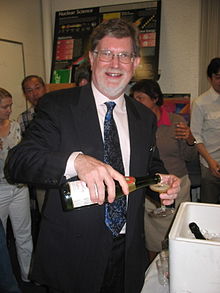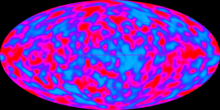George F. Smoot

George Fitzgerald Smoot III (lahir 20 Februari 1945) merupakan seorang ahli astrofizik dan kosmologi Amerika Syarikat.
Beliau juga merupakan seorang professor fizik di University of California, Berkeley. Beliau telah dianugerahkan Hadiah Nobel dalam Fizik 2006, berkongsi dengan John C. Mather kerana "penemuan mereka terhadap bentuk jasad hitam dan anisotrofi latarbelakang gelombang mikro kosmik". Penemuan ini menolong mengukuhkan teori big-bang alam semesta menggunakan satelit COBE (Cosmic Background Explorer). Merujuk kepada ahli jawatankuasa Hadiah Nobel, "projek COBE boleh dianggap sebagai titik permulaan kosmologi sebagai satu sains yang tepat". [1]
Biografi
[sunting | sunting sumber]Pendidikan dan permulaan penyelidikan
[sunting | sunting sumber]Smoot telah lahir pada 20 Februari 1945 di Yukon, Florida. Beliau telah mempelajari matematik sebelum bertukar ke Massachusetts Institute of Technology di mana beliau memperolehi dua sarjana muda dalam matematik dan fizik dalam 1966, dan satu ijazah kedoktoran di fizik zarah dalam tahun 1970.[2] Kemudian beliau telah bertukar ke bidang kosmologi, dan telah pergi ke Makmal Kebangsaan Lawrence Berkeley di mana beliau telah berkolaborasi dengan Luis Walter Alvarez berkenaan dengan eksperimen HAPPE, satu belon stratosfera bagi mengesan antijisim dalam atmosfera atas, di mana ia telah diramal oleh keadaan tetap model kosmologi yang kini samar-samar.
Kemudian beliau mengambil minat dalam latarbelakang gelombang mikro kosmik (CMB), sebelum ini ditemukan oleh Arno Allan Penzias dan Robert Woodrow Wilson. Satu persoalan yang belum diselesaikan pada masa itu adalah struktur alam semesta. Certain models predicted the universe to be in rotation, which left a trace in the CMB in the form of temperature depending on the direction of observation. With the help of Alvarez and Richard A. Muller, he developed a differential radiometer which measured the difference in temperature of the CMB between two directions 60 degrees apart. The instrument, which was mounted on a Lockheed U-2 plane, made it possible to determine that the overall rotation of the universe was null (within the limit of accuracy of the instrument). It detected a variation in the temperature of the CMB corresponding to a dipole, interpreted as the Doppler effect of the Earth's motion relative to the area of CMB emission, which is called the last scattering surface. Such a doppler effect arises because the Sun (and in fact the Milky Way as a whole) is not stationary, but rather is moving at nearly 600 km/s with respect to the last scattering surface. This is probably due to the gravitational attraction between our galaxy and a concentration of mass like the Great Attractor.
Although Smoot attended MIT, he was not the same Smoot who was laid end to end to measure the Harvard Bridge between Cambridge and Boston; this was Oliver R. Smoot. This confusion was clarified by George Smoot himself.
Pengllibatan dalam COBE
[sunting | sunting sumber]
At that time, the CMB appeared to be perfectly uniform excluding the distortion caused by the Doppler effect as mentioned above. This result contradicted with observations of the universe, with various structures (galaxies, galaxy clusters, etc.), indicating that the universe was relatively inhomogenous on a small scale. However, these structures formed slowly. Thus, if the universe is inhomogenous today, it would be inhomogenous at the time of the emission of the CMB as well, observable today through weak variations in the temperature of the CMB. It was the detection of these anisotropies that Smoot was working on in the late 1970s. He then proposed to NASA a project involving a satellite equipped with a detector that was similar to the one mounted on the U-2, but was more sensitive and not influenced by air pollution. The proposal was accepted and gave rise to the satellite COBE, and cost US$ 160 million. COBE was launched on November 18, 1989, after a delay owing to the destruction of the Space Shuttle Challenger. After more than two years of observation and analysis, the team of COBE, led by Smoot, announced on 23 April 1992 to have detected negligible fluctuations in the CMB, a breakthrough in the scientific world. [3]
The success of COBE was the outcome of prodigious team work involving more than 1,000 researchers, engineers and other participants. John Mather coordinated the entire process and also had primary responsibility for the experiment that revealed the blackbody form of the CMB measured by COBE. George Smoot had main responsibility for measuring the small variations in the temperature of the radiation[4].
Smoot collaborated with San Francisco Chronicle journalist Keay Davidson to write the general-audience book Wrinkles in Time [5], first published in 1994, that chronicled his team's efforts.
Projek masakini
[sunting | sunting sumber]After COBE, Smoot took part in another experiment involving a stratospheric balloon, MAXIMA, which was more precise than COBE, and refined the measurements of the anistrophies of the CMB. He is also a collaborator in SNAP, a satellite which is proposed to measured properties of dark energy, and data from the Spitzer Space Telescope in connection with infra-red radiation.
Rujukan luar
[sunting | sunting sumber]- Nobel Prize announcement
- Biography at the Lawrence Berkeley National Laboratory
- Berkeley lab article Diarkibkan 2006-11-18 di Wayback Machine
Pautan luar
[sunting | sunting sumber]Rujukan
[sunting | sunting sumber]- ^ "Information for the public" (PDF). The Royal Swedish Academy of Sciences. 2006-10-03. Dicapai pada 2006-10-05.
- ^ "Nobelists' work supports big-bang theory" (Siaran akhbar). MIT Press Office. 2006-10-03. Dicapai pada 2006-10-03.
- ^ Smoot, G. F et al., Structure in the COBE differential microwave radiometer first-year maps, Astrophysical Journal 396, L1 (1992)
- ^ Press release: Pictures of a newborn Universe
- ^ Wrinkles in Time by George Smoot and Keay Davidson, Harper Perennial, Reprint edition (October 1, 1994) ISBN 0380720442


